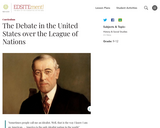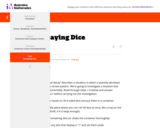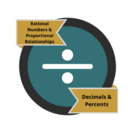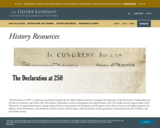
A testimonial by a women regarding her work in a sweatshop at the turn of the 20th century.
- Subject:
- History
- Material Type:
- Primary Source
- Provider:
- Cornell University
- Date Added:
- 03/22/2024

A testimonial by a women regarding her work in a sweatshop at the turn of the 20th century.

This three-act film tells the story of the detective work that solved the mystery of what caused the disappearance of the dinosaurs at the end of the Cretaceous period. Shot on location in Italy, Spain, Texas, Colorado, and North Dakota, the film traces the uncovering of key clues that led to the discovery that an asteroid struck the Earth 66 million years ago, triggering a mass extinction of animals, plants, and microorganisms. Science practices in geology, physics, biology, chemistry and paleontology all contributed to the solution to this compelling mystery. Lesson plans are included that have students identify evidence and construct an explanation to tie it together. Summary questions are included at the end and a class discussion is recommended. (This activity will be the only one evaluated in this review.) Another resource is Finding the Crater where students visit different K-T boundary sites. There are also lessons where students analyze various characteristics of the asteroid such as its size and energy, chemical data about the asteroid, and the iridium fallout from an asteroid impact. A hands-on activity where students study the differences in foraminifera fossils below and above the K-T boundary is also included as well as an article that outlines more details about each of the discoveries covered in the film. You can view the film on the website or HHMI will send you a free DVD. Lesson plans including teacher notes and a student handout can be found at http://www.hhmi.org/biointeractive/following-trail-evidence.

From Earth’s moon to Europa, our solar system is filled with interesting set of natural satellites. Through art and science, children learn about moons of our solar system with the Deadly Moons activity.

Sixteen dancers from across the country, representing a range of dance styles, move as one being, with each dancer's moves flowing naturally into the next. Poet Chinaka Hodge narrates each dancer’s steps from all around the United States as we shelter-in-place. Inspired by Mitchell Rose's Exquisite Corps chain letter, each dancer begins in the last pose of the dancer before passing the movement.
If Cities Could Dance is a Webby Award-winning video series featuring dancers from cities across the United States. Step into the shoes of dancers from across the country who dare to imagine what it would look like if their city could dance.
Extension Project: Give your middle and high school students the opportunity to create and publish original dance videos with an accompanying artist statement with the KQED Youth Media Challenge: If Schools Could Dance.

Students write persuasive letters to their librarian requesting that specific texts be added to the school library. As they work, students plan their arguments and outline their reasons and examples.

American foreign policy continues to resonate with the issues surrounding the debate over U.S. entry into the League of Nations-collective security versus national sovereignty, idealism versus pragmatism, the responsibilities of powerful nations, the use of force to accomplish idealistic goals, the idea of America. Understanding the debate over the League and the consequences of its ultimate failure provides insight into international affairs in the years since the end of the Great War.

In this debates and mock election lesson plan, which is adaptable for grades 3 through 5, students use BrainPOP resources to explore the differences between the Democratic and Republican political parties. Students then create a presidential race within their school and perform the parts of a formal debate.

Resource from KQED that includes links, video links, guidance and activity investigating the pros and cons of the electoral college

This task provides concrete experience with exponential decay. It is intended for students who know what exponential functions are, but may not have much experience with them, perhaps in an Algebra 1 course.

This discussion guide is for use with the video âDeciding Difficult Cases,â which features Jeffrey Rosen, president and CEO of the National Constitution Center, interviewing the Hon. Emmet G. Sullivan, U.S. District Court for the District of Columbia, at the Fair and Impartial Judiciary Symposium on October 26, 2019, at the University of Pennsylvania Law School.

This microcredential represents a teacher’s understanding of decimal and percent concepts and their ability to understand and respond to developmentally appropriate learning trajectories/progressions related to decimal and percent concepts by planning and implementing instruction based on the Standards for Mathematical Practice and Effective Mathematics Teaching Practices. It includes selecting, using, and adapting mathematics curricula and teaching materials, including the integration of mathematical tools and technology, as well as using and analyzing formative and summative assessments to determine where students are in learning trajectories related to fraction concepts. This is the third of seven microcredentials in the Elementary Mathematics Endorsement: Rational Numbers and Proportional Reasoning. These microcredentials can be earned in any order.
Students will be able to describe the decision-making process, including acceptance of personal responsibility for the consequences of the decision and describe the decision-making process (identify problem, brainstorm possible solutions, explore and evaluate, make a decision and act on it, evaluate and accept responsibility for results).

The decisions teenagers make are influenced by many factors. This lesson will help students differentiate between a variety of influences and recognize the impact these influences have on decision making.This lesson is written as an interdisciplinary unit for both the Health and Language Arts classrooms. It can however, be taught in just one of the classes.

Decision making is the process of making choices by identifying a decision, gathering information, and assessing alternative resolutions.
Using a step-by-step decision-making process can help you make more deliberate, thoughtful decisions by organizing relevant information and defining alternatives. This approach increases the chances that you will choose the most satisfying alternative possible.

This video segment, adapted from Decision in the Streets by civil rights filmmaker Harvey Richards, portrays the interracial protests that took place in San Francisco in 1963-64.

Multi-year initiative recognizing the importance of the Declaration of Independence in the history of the U.S. and the world.

Since 2005, the "Past and Present" podcast from Colonial Williamsburg has taken you behind the scenes to meet interpreters, chefs, tradesmen, musicians, historians, curators, and more. We offer two versions of our podcast: one that's audio-only and one that includes a slideshow. In this episode: Hear the Declaration of Independence read in its entirety by renowned Thomas Jefferson interpreter Bill Barker.

Most students are familiar with the Declaration of Independence. But have they ever critically examined the text or questioned the motives of its authors? In this lesson plan, students weigh contrasting interpretations by prominent historians to answer the question: Why did the Founders write the Declaration of Independence?
The second part of the lesson encourages students to think through what the Declaration of Independence means and what the grievances meant.

This is a facsimile of the Declaration of Independence, adopted by the Continental Congress on July 4, 1776.

This lesson plan looks at the major ideas in the Declaration of Independence, their origins, the Americans' key grievances against the King and Parliament, their assertion of sovereignty, and the Declaration's process of revision.